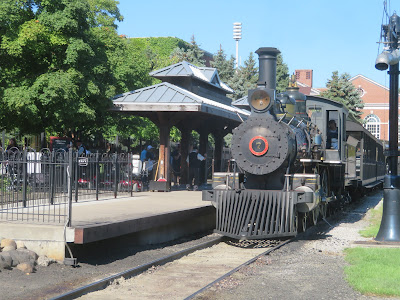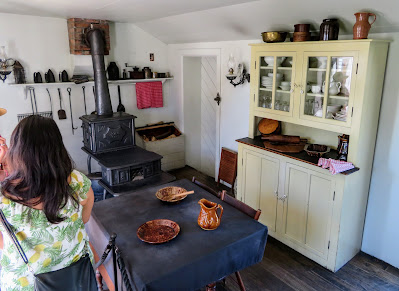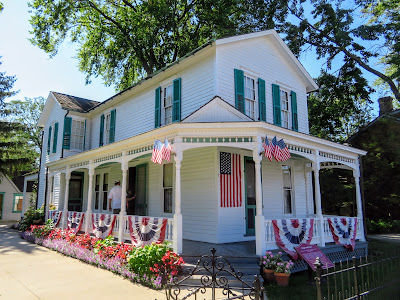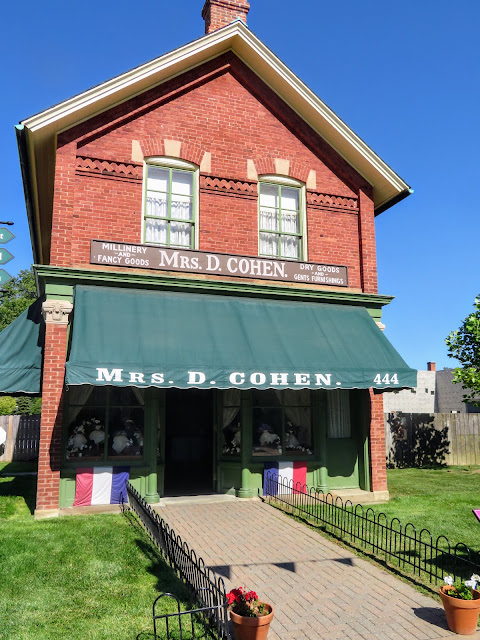Resuming our late summer road trip we departed Jackson Michigan early one morning and headed toward Dearborn Michigan and Greenfield Village and the adjacent Henry Ford Museum. The last time that Laurie and I visited the museum complex had to be close to 40 years ago.
‘The
Henry Ford’ as it’s known, is also known as the Henry Ford Museum of American
Innovation and Greenfield Village, aka the Edison Institute. Combined, the museum and village is the
largest indoor-outdoor museum complex in the United States. The Henry Ford museum complex is visited by
more than 1,700,000 people every year.
We
started our tour with Greenfield Village, the outdoor living history museum
portion of the Henry Ford Complex. It was
opened to the public in 1933. Almost 100
historical buildings were moved to the property from their original locations
and other reconstructions of historical structures are also on site. To be clear, there was no way that Laurie and
I could visit every important building or site on this 90 acre site, especially
since we also planned to tour the indoor portion of the Henry Ford.
General admission for the two of us cost $87.50. After buying our tickets, we headed through the gates and one of the first items of interest that I encountered was this train full of visitors.
Steam
locomotive #7 was built by the Baldwin Locomotive Works in Philadelphia in
1897. The tender shows that it had been
in service for the Detroit and Lima Northern Railroad. The 2.5 mile rail loop in Greenfield Village
began operations in 1972. The Village
operates 3 different steam locomotives.
We didn’t ride the train as lines were long and our time was limited.
Henry Ford’s father, William built this barn near present-day Dearborn in 1863, which happens to be the year that Henry was born. It was primarily used to store grain and hay although sometimes livestock and tools were kept here. In 1933, the barn was moved to Chicago for the World’s Fair where it was the home of machinery processing soybeans. After the Fair it was moved to Greenfield Village, where the Village’s horses are groomed and cared for.
Henry Ford was born in this farmhouse on July 30, 1863. The house was built ca. 1860-1861 in what is now Dearborn Michigan. Henry grew up here but wasn’t interested in farming. At the age of 16 he moved out and went to Detroit to find work as a machinist.
Henry
Ford restored his former family home back in 1919…moving it to Greenfield
Village in 1944. Henry insisted that the
home be restored exactly as he remembered it.
That Victorian style living room sure has a lot going on design and contrast wise. Ford had people searching the
country for about 18 months looking for a dining room stove that matched the
one that he recalled from his youth.
In addition to the train circling Greenfield Village, old Ford vehicles with drivers are available for visitors to ride around in. Vehicle styles were all over the place including early ‘woodies’, convertibles and even a bus.
This is the 15,000,000th Model T Ford that was built! On May 26, 1927, Edsel and Henry Food drove the fifteen-millionth Model T, a touring model, out of the Highland Park Ford plant. This marked the end of the Model T line and the start of Model A production.
This is Wilbur and Orville Wright’s cycle shop in Greenfield Village. It was built in Dayton Ohio ca. 1875 and the brothers operated their bicycle business in this building from 1897 to 1908. Wilbur and Orville sold and repaired bikes and they also produced models under their own brands. This is also the shop where the Wright brothers built their earliest flying machines, including the 1903 “Flyer” that became the first heavier-than-air, powered and controlled aircraft.
This is
an old photo of the Wright Cycle Shop. Henry
Ford acquired the Wright brothers’ home as well as the cycle shop in 1936,
relocating them to Greenfield Village.
In the village setting, the home and shop are right next to each other
but in Dayton, the 2 buildings had been a few blocks apart.
Notes:
· Henry Ford was very interested in airplanes. A Ford company began production of the Ford Trimotor in 1925. Production ceased in June of 1933, after 199 Trimotors had been built. Over 100 airlines have flown a Trimotor on one or more routes. In addition, the US Army Air Force, the US Navy and the Canadian Air Force all flew Ford Trimotors.
· In 1925, Ford initiated Ford Air Transport Service, the world’s first regularly scheduled commercial cargo airline. The company flew routes from Detroit to Cleveland and to Chicago.
· Currently there are about 6 airworthy Ford
Trimotors in operation. They tour the
country and give short rides to paying passengers. Just 4 or 5 years ago, Laurie and I flew over
Knoxville Tennessee on an original Ford Trimotor operated by the Experimental
Aircraft Association. There seemingly more
Ford Trimotors available for passengers here in the USA than there are Douglas
DC – 3’s, and over 20,000 of the latter or their military variants were built.
Although the Wright family moved around a bit, brothers Wilbur and Orville always considered this house, built ca. 1870 (modified in 1900) and originally located at 7 Hawthorne Street in Dayton Ohio, as their home. Once again, we can see the over-the-top Victorian décor. Orville was born in this house in 1871 and Wilbur died here in 1912.
Susan, the brothers’ mother encouraged the boys to work with tools and machinery. The Wright Brothers interest in flight was piqued when their father gave them a toy fashion with a stick and blades…powered by a rubber band, which would lift up in the air when the band was tightened up.
Orville
Wright (1871 – 1948) and Wilbur Wright (1867 – 1912) were of course, American
aviation pioneers generally, (but not universally), given credit with
inventing, building and flying the world’s first successful motor driven
airplane. They were also the first to
invent aircraft controls that made fixed-wing powered flight possible. Neither brother ever married and Wilbur once
remarked that he ‘did not have time for both a wife and an airplane. Were the Wright Brothers a big deal back in
the early part of the 20th century?
Count on it! On October 4, 1909,
Wilbur made a flight in front of a million people in the New York City area…as
part of the Hudson-Fulton Celebration.
The Cohen Millinery Store was built in 1880 in the city of Detroit Michigan. Over the years the building sold groceries, dry goods, flour and feed but in the mid-1890s, a widow named Elizabeth Cohen operated a millinery shop in this structure. She supported her young family by selling relatively inexpensive but fashionable headwear made with mass-produced components. Her customers were middle-class consumers who were becoming more fashion conscious.
I love
that old stove. Many of the stoves built
in the 1800s and early 1900s were works of art.
This Argand stove was built by the Perry Stove Works in Albany New
York. That company was founded in
1869. Changing its name to the Albany
Stove Works, by the end of the 1800s, the company employed 1,200 workers.
This is a
photo of the Cohen Millinery Store ca. 1895, includes Mrs. Cohen with her daughter
in front of the store. She and her
family lived above the store, making it much easier to take care of business
and her children. This was during a time
when very few income/job opportunities were available for women.
Shops
specializing in a plethora of products served the needs of city dwellers long
before mass merchandising and chain stores came on the scene. Even as recently as the mid-1950s, my own
neighborhood in Jackson Michigan (Douglas Street), was served by 2 local corner
grocers, both just 2 – 5 blocks from our home.
This is the Henry J. Heinz house. It was built in 1854 in Sharpsburg Pennsylvania. Henry Heinz started his ‘food empire’ by bottling horseradish in the basement of this, his parent’s home. His products expanded to include a variety of pickles and relishes to neighbors. After a few years, he moved his operation to Pittsburg Pennsylvania.
Henry Heinz helped his father build the house and he lived in it from the age of 10 until he got married when he was 25. Henry decided to move the house to the main plant where it could serve as a museum where visitors could learn about the company’s history. In 1904 the house was moved intact from Sharpsburg…5 miles up the Allegheny River. The photo above shows how it was situated adjacent to the Heinz plant in Pittsburgh. In 1952, the house was dismantled and rebuilt in Greenfield Village.
When you have a lot of money, you can buy just about anything that catches your eye. Henry Ford was a multi-multi billionaire adjusted to today’s dollar value, perhaps the richest private citizen ever. Sir John Bennett’s Jewelry Store in London grabbed Ford’s attention when he saw it. Ford was a watch enthusiast and the sight of the mythical giants, Gog and Magog, who are part of the building’s clock mechanism, really grabbed his attention!
Sir John
Bennett moved into the structure in 1846 and that’s when he installed the giants
as part of the clock’s operation. Sir
John made and repaired watches and clocks for royalty and other wealthy English
citizens. Sir John was also a bit of a
character. He has been described as a “flamboyant
personality who seems to have aroused in his contemporaries varying degrees of
ridicule, hostility, and admiration”.
Henry
Ford purchased the building for Greenfield Village in 1928. Originally a 5-story building, it was
reassembled in a 2-story scale, making it more compatible with other village
structures. Other than the 2 mythical figures,
only the façade and the clock mechanism are from the original building. Gog and Magog entertain visitors to the
Village when they strike different toned bells every quarter hour with their
hammers…
There
will be one more post about some of the highlights of Greenfield Village before
moving on to the Ford Museum’s indoor exhibits.
Just click
on any of the photos to enlarge them…
Thanks
for stopping by for a photo!
Take
Care, Big Daddy Dave




















Looks like a very interesting place and amazed they moved the brick buildings.
ReplyDelete$87.50!! Why are museum tickets so expensive? The fifteen-millionth Ford are a beauty.
ReplyDeleteI'll be back when I have time to read all of this...
ReplyDeleteNow I've scrolled through, and I know there was much much more that you've not had a chance to include. Thanks so much!
ReplyDeleteDear Dave, Looks like a wonderful road trip, So much history and so much to learn. Love reading the history and learning. Take care.
ReplyDelete